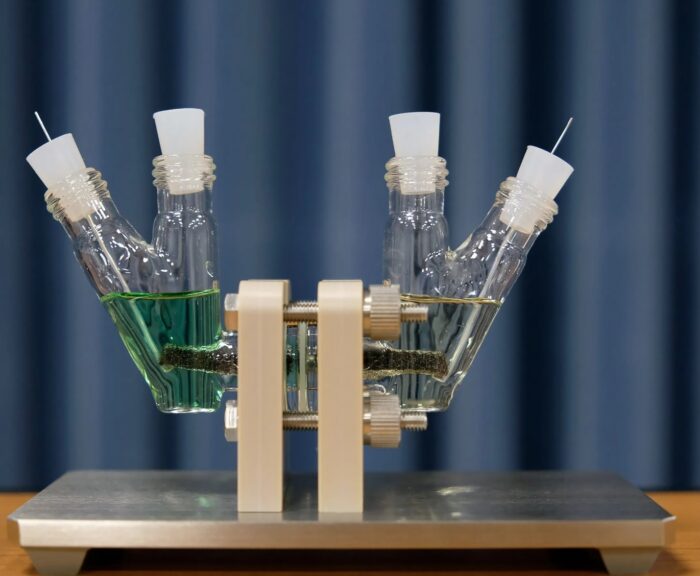Jul 31 2025
Depleted Uranium Batteries
 The Japan Atomic Energy Agency reported earlier this year that is has developed and tested a battery with depleted uranium as the active material of the negative electrode. Why would they do this, and what role could such a battery play? First let’s look at the details (which are sparse).
The Japan Atomic Energy Agency reported earlier this year that is has developed and tested a battery with depleted uranium as the active material of the negative electrode. Why would they do this, and what role could such a battery play? First let’s look at the details (which are sparse).
The battery uses depleted uranium and iron as the electrodes with a liquid electrolyte. The prototype battery was able to generate 1.3 volts, a little less than a AA battery (1.5 volts). They were also able to discharge and recharge it 10 times with little loss of capacity. That’s the basic info I have – not very impressive. Grid storage batteries typically operate in the 400-800 volt range. You can just connect batteries in series to add their voltages, so one battery like the prototype would be a single cell of a larger battery pack. What we really need to know is the capacity of this battery, which was not reported. Also – 10 cycles is nothing. Grid storage batteries would need to be stable over thousands of recharge cycles.
As is almost always the case, the developers are working on “scaling up” their prototype – making it more efficient with higher voltage and capacity. That means the technology is not ready for prime time yet. They are also reporting:
“The research team is now developing flow cells including electrodes for a higher-capacity battery. The larger design would use 650 tonnes of uranium and have a capacity of 30,000 kilowatt-hours, roughly equivalent to the daily electricity supplied to 3,000 households in Japan.”
That is reasonable capacity for grid storage, but again this is the plan, not yet reality. So – why even bother using depleted uranium for a battery design? The big limitation with uranium is that it is radioactive, which means that such a battery would need shielding and is affected by nuclear safety regulations. While this is a regulatory issue, the amount of radiation is minor. Depleted uranium is mostly U238, which has a half-life of 4.468 billion years. The longer the half life the lower the intensity of the radiation – so this is giving off a tiny amount of radiation over a very long time. Enriched uranium, is mostly U235, which is highly radioactive (half life of 700 million years) and U234 (half life of 246,000 years), and is mostly removed from the depleted uranium. So really the radioactivity, while an issue, is not a deal-killer.
Uranium is also a heavy metal. It’s health hazard comes more from its chemical toxicity than its radioactivity. So again, it will have to be carefully handled.
Uranium is also a terrible choice for a battery material if you are concerned with specific capacity – the capacity per mass. There is a reason lithium is used for car batteries – lithium is the third element on the periodic table. It is relatively light. Uranium is super heavy. So these batteries would not be used if weight is a concern, however they are still usable for stationary grid storage where weight is not really an issue.
Let’s get to the reason why Japan is interested in developed depleted uranium batteries – because they have 16,000 tonnes of the stuff that they have to store, and are making more every day. The US has 750,000 tonnes. The idea is to use this material, which is just sitting in storage, for something useful. Let’s do a little math – they report that in the flow cell design they expect a capacity of 30,000 KWh from 650 tonnes of depleted uranium. If they used the entire 16,000 tonnes that would be about 24 times as much, or 738,000 KWh, enough to power about 73,000 homes. For the US (assuming the same energy usage per home) 750,000 tonnes would be 3.4 million homes.
That is not insignificant. I like the idea, if they can get the technology to work with sufficient battery parameters and in a reasonably cost-effective way. I always like the idea of killing two birds with one stone. Depleted uranium is a nuclear waste product that needs to be stored. This way, it would essentially be stored as battery grid storage. Further, we will need lots of grid storage going forward. We do not want to make grid storage batteries out of lithium – we need the light stuff for cars and planes. We should make grid storage batteries out of abundant cheap material, and it doesn’t matter if its heavy. Uranium and iron fit the bill.
The radioactivity is at a very low level, so shielding could be minimal. The batteries could be fairly remote as long as they have grid access. The whole thing seems workable. There is always the issue of public acceptance, but we just need to deal with that. We need to emphasize risk vs benefit. The risk here is low, and if this helps accelerate our transition to low carbon energy, the benefit is huge. So suck it up. These are exactly the kind of solutions we need to find.
It also does not matter that this would not be enough to be the only grid storage solution. So what? We don’t need or want one solution. We can stitch together lots of partial solutions. On the scale that we are talking about, availability of raw material is a huge issue. We don’t produce enough copper, for example, to build the EV batteries, grid expansions, grid storage, solar panels, and wind turbines that we need. It’s a limiting factor. Anything that can displace the need for copper, or lithium, or rare earths, is hugely beneficial.
This is a prototype, so we still don’t know if it will work. I hope it does.






